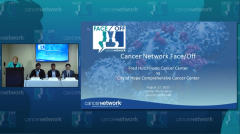
Biochemical and Clinical Progression: The Two Faces of Relapsed MM
Andrew Cowan, MD, discusses the complexities of relapsed multiple myeloma, distinguishing between biochemical and clinical progression, analyzing survival data, and raising questions about optimal treatment strategies.
Episodes in this series

Transcript:
Judy Schreiber, PhD, RN: We’ll go ahead and get started with the first presentation, which is being done by Dr Cowan. Go ahead and start with that. Then we’ll go to questions. Thank you.
Andrew J. Cowan, MD: Good morning…all. My name is Andrew Cowan. I’m the clinical director of the Multiple Myeloma Clinic at Fred Hutch[inson Cancer Center]. Today I’m going to be reviewing some data with you regarding…2 sides of relapsed multiple myeloma, biochemical progression and clinical progression. Here’s my COI. I think when we treat multiple myeloma in the frontline setting, we typically start out with a quadruplet combination followed by autologous stem cell transplant in eligible patients, followed by either lenalidomide or combination-based maintenance. Patients can do quite well [with] this for many years. However, all of us who treat multiple myeloma know that over time, we start to see rising indices of disease.… The term for this in the literature is biochemical relapse. For anyone who remembers, there’s a similar concept in…prostate cancer when you have a rising PSA, but there’s no evidence of clinical disease progression.
We have that analogy in multiple myeloma where we have an increasing level of free light chains or an increasing monoclonal protein. But…importantly, you have to make sure that that patient doesn’t have clinical progression. Typically what we would do is when someone has a biochemical progression, we would obtain imaging, repeat a bone marrow [biopsy] perhaps, and make sure that that patient doesn’t have clinical progression assuming that they’re not anemic and their creatinine is normal. If they’re not, then oftentimes we might opt just to monitor that patient for some time. Clinical progression, on the other hand, is our old friend…CRAB [calcium elevation, renal insufficiency, anemia, bone abnormalities].
Anyone who’s watched SpongeBob know that he’s not a nice guy. CRAB is not a nice thing in myeloma. We can see this really [with] any monoclonal protein. Monoclonal protein of 0.2, you can see patients with pretty massive plasmacytoma. You can’t assume just because the M-spike is low that the clinical progression isn’t there. That’s why you always have to monitor for it. These are the 2 faces of multiple myeloma. That’s why I put Janus, the Greek god of transitions, in the middle…because we can see both. Sometimes, it’s hard to predict when someone’s going to develop one or the other.
Also, [it’s] important to note that relapsed multiple myeloma is not 1 disease. Anyone who treats the disease knows this. You can have relapsed multiple myeloma that’s very aggressive with multiple relapses in a short period of time, like the red curve. Or you can have a very indolent, almost follicular lymphoma-like course where relapse may take 10 or 15 years. Also important is that relapsed multiple myeloma is a very biologically and genetically heterogeneous disease. I think this is where the challenge comes in and why you can’t really take a one-size-fits-all approach to managing biochemical or clinical progression and why some patients may present very differently. But the focus of this is really talking about the patients who have clinical or biochemical progression.
And so, what data do we have? And then I’ll get into the paper that we want to focus on. There was a study from a Spanish group, 211 patients posttransplant. They analyzed those patients and found that patients who had a biochemical progression did better than a clinical progression, which seems like a no-brainer to me. Another analysis from the Cleveland Clinic, 250 patients. First relapse, pattern of progression, did have a significant impact on overall survival. The Spanish group also presented data and really didn’t show much difference in survival. There was a recent analysis in Blood Advances that looked at a very large group of patients. I think anyone who knows this field knows where this study was likely conducted. It was a rural center in Minnesota [with] 1347 patients with relapsed multiple myeloma. At least 1 relapse…required an additional treatment.
They broke it down into 2 groups, clinical progression [and] biochemical progression. They defined biochemical progression as an increase in the monoclonal protein leading to a new line of therapy, whereas clinical progression is…CRAB, our friend. They also had a subset of aggressive relapse. They analyzed the outcomes of these patients. Sixty percent had biochemical progression; 40% had clinical progression. You were most likely to relapse with the same CRAB feature you had at diagnosis, which I think rings true…having treated these patients.
[These are] the Kaplan-Meier curves that show the estimated survival for folks who had biochemical [relapse] in the blue, clinical progression in the green, or aggressive relapse. I think this fits with our experience. The patients who experienced biochemical progression in the absence of clinical progression tend to have a more indolent disease score. This is reflected in the data. I’m sorry I went a little bit over. But just to summarize, in this study of 1347 patients, treatment of biochemical progression vs clinical progression appeared to demonstrate superior outcomes. That was something that I wasn’t able to get in earlier. But they found that if you treated biochemical progression, patients did better.
But…there [are] some questions I have about this. Do patients with biochemical relapse only have just more indolent disease? We’re…selecting out patients with good disease biology. How do you really know that treatment is going to be superior for these patients? In patients who have a biochemical relapse, what’s the optimal time for treatment initiation? Most trials require an M-spike of 0.5 or 1 for enrollment. But really, there’s nothing magical about an M-spike of 0.5 or 1. It’s just where we’ve all decided that treatment should be started. When do we start? Or is it the kinetics of the M-spike increasing that is more important? And can we predict which patients have that evolving clinical progression and initiate treatment before onset of symptoms?
Transcript is AI-generated and edited for clarity and readability.
Newsletter
Stay up to date on recent advances in the multidisciplinary approach to cancer.



















































































